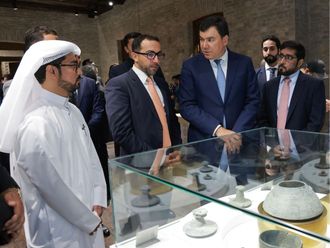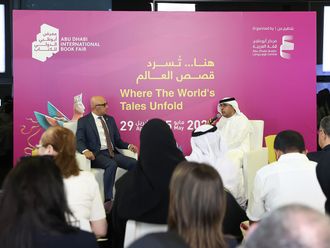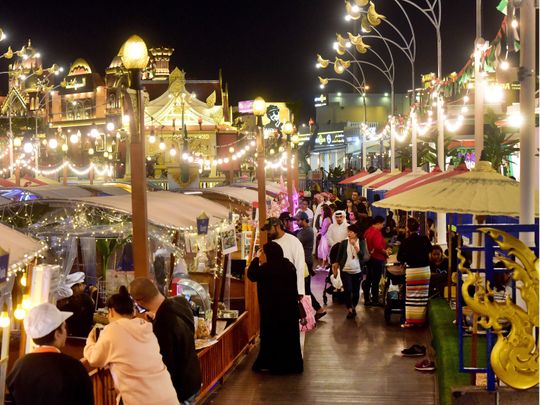
A theme park like none other in the world...
- The best of global cuisine
- Rides, shopping and floating market
- International music concerts, stage shows and stunts
- A happiness index of 9/10
Reporting: Anjana Kumar, Web Reporter, Rabab Khan, Community Interactivity Editor, Evangeline Elsa, Community Solutions Editor, Sara Al Shurafa, Web News Editor, Huda Tabrez, Community Web Editor, Yousra Zaki, Web Features Editor, Shreya Bhatia, Reader Interactivity Journalist, Falah Gulzar, Trainee with Social Media Team, and Anupa Kurian-Murshed, Social Media Editor
Is it a carnival? Is it a bargain paradise? Is it a place to discover ethnic arts and crafts? Or a foodie haven? The answer - it's all that and then some more.
A place where the world can be found in a village.
At every turn you can explore, experience and enjoy something that holds your senses in thrall. Global Village or GV (as known by those in the know) has no precedent and after 23 years, is an integral part of the Dubai diary of things to do.
Yes, we know it can be a tad intimidating in scale and size, so we have created a curated guide. It is based on the five senses - sight, hearing, taste, smell, and touch - of things that we believe you should not miss.
But, first a brief history...
Now, in its 23rd edition, the Global Village was first launched in 1997 at the Dubai Creekside. The purpose behind inaugrating the village was to portray the UAE’s spirit of tolerance. The concept brought together various cultures from around the world, which is evident in the UAE already, with people from around 200 different nationalities living here.
Since its inception, it has had four locations — Dubai Creekside, Oud Metha, Dubai Festival City and finally moved to its current location, Dubailand, in 2005.

When it first began, Global Village hosted cultures from 18 countries. In its latest season, the destination hosts cultures from 78 countries. Initially, all the pavilions were the same size. But, in its current location, things have changed. The India pavilion is the largest now and spreads across 11,000 square meters.
The park currently spreads across 1.6m square metres, including the parking space. Infrastructure enhancements continue every season, which include revisions on the master plan to ensure guest safety and comfort. For instance, eight new pedestrian bridges have been constructed this season to facilitate the movement of the visitors.

Last year, the park scored the world record for the largest cup of hot tea in the world, which had 5,000 litres of karak tea that was prepared by 180 chefs over 12 hours. The end product was distributed for free to 50,000 guests.
This year, the park runs from October 30, 2018 to April 6, 2019 and the organisers hope to entertain a similar number of people as last year.
To view this year's map, click here.
Sights
GV is a swirl of colours, from the elaborate African pavilion art to ancient handicrafts such as Berber carpet-making, everything is a sight for sore eyes.
The African heritage village
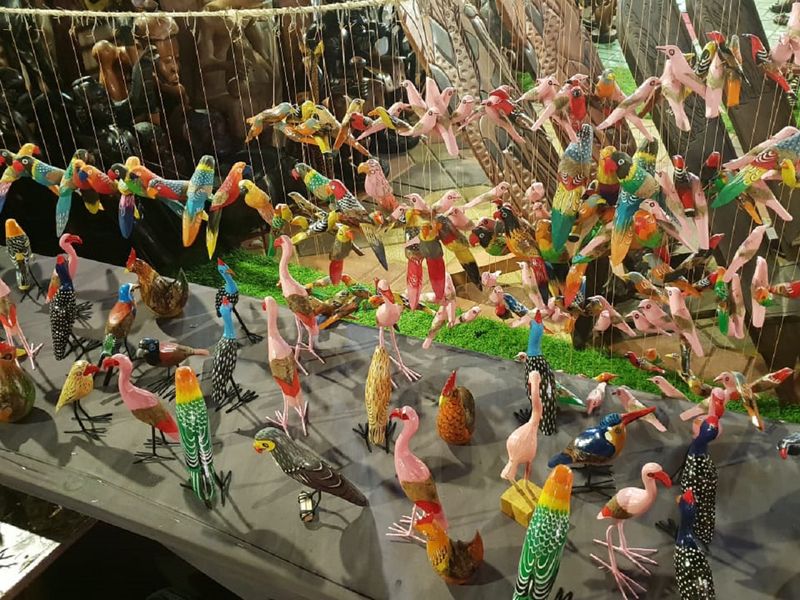
Located inside the African pavilion, it has sculptures, colourful art, and wooden figurines - a must see for art fanatics.
African artists use locally-sourced materials to create wonderful art pieces. Artist Simon Ndungu Githu explained how he made banana fibre art. These are created by layering different parts of banana trees, to achieve different textures that together, complete a picture. He said: “We don’t use any kind of artificial colouring, I use natural banana leaves and fibre.”
The big pieces take three to four days and cost nearly Dh200 while the small ones can be made within a day and cost Dh20.
John Glemba, another artist working on hand-painted wooden bird sculptures, showed us the process: “I first do the carving, I sand and paint it. Once that is done I varnish it to make it waterproof.” The small birds cost Dh20.
Bidri art from India
This art form originated in the Indian state of Karnataka. Popularised by sultans who ruled Bidar in the 14th and 15th centuries. Bidriware was brought to India by followers of the Sufi saint Khwaja Moinuddin Chishti, from Iran.
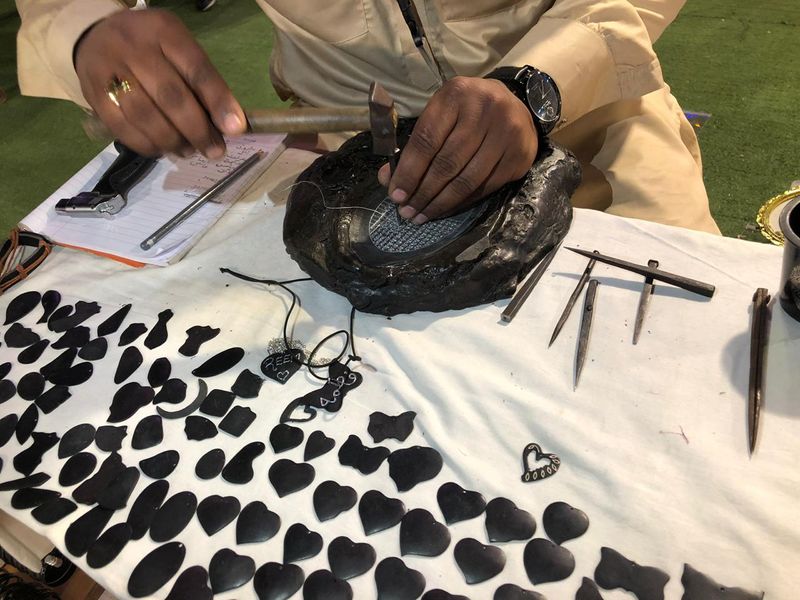
The art requires the unique soil, which is available only in the Bidar fort area. Some artisans claim the soil has remained hidden from sunlight and rain for years and has great oxidizing properties that give Bidriware a lustrous, black colour. Others believe that the part of the fort from where the soil is collected was a mine in the past. Bidri art is a skill that is passed on from generation to generation.
According to artist Mohammad Salman Ahmad: “It is a 700-year-old art form and very few families are currently practising it.”
He explained the long and complicated process of preparing a Bidri artefact: “Silver is inlaid on gunmetal, a blackened alloy of zinc and copper. The material is first cast in moulds made from wax or clay, sand, resin and oil. Using chisels, artist engrave intricate designs on the metal. A silver metallic wire is then laid in the engraved area and hammered in softly to flatten. The item is cleaned and polished to be finally put in copper sulphate solution which gives it the dark colour."
Colours of Pakistan
It’s impossible to take a stroll across the Pakistan pavilion and miss the art that lines it. From beautiful embroidery to carefully woven carpets, the shops showcase the rich culture of the South Asian country. Particularly interesting is the traditional handloom set up right in the middle of the pavilion.
Mohammad Riaz, a professional weaver has been flown in from Multan, Pakistan, to demonstrate the centuries-old art form. He uses his hands and feet to weave natural fibre into cloth using a manual loom. Although various types of cloth can be made using the device, Riaz said he makes Khaddar, a hand spun cloth unique to the subcontinent.
Another interesting display is the live pottery making taking place just outside the stall. The art form has been a part of Pakistan and the region since prehistoric times. Clay vessels found from the Indus Valley civilization point to the importance the craft has held through history. Zia Ulla, a potter who has been doing it for about 50 years has been especially flown in from Pakistan’s Gujarat region. Carefully shaping wet clay with his hands and a bucket of water, he crafts beautiful pots, taking just a couple of minutes for each.

Stall art – it’s all in the details
In Global Village, the interesting sights begin right at the entrance. Each corner is filled with elaborate structures, models and designs. Gate of the World is one of two public entrances at the park and it’s just what its name says. Once you enter, scaled-down structures of famous landmarks from around the world line the entrance. From seeing the Taj Mahal, the Eiffel Tower to our very own Burj Khalifa, you can take a quick trip around the globe.
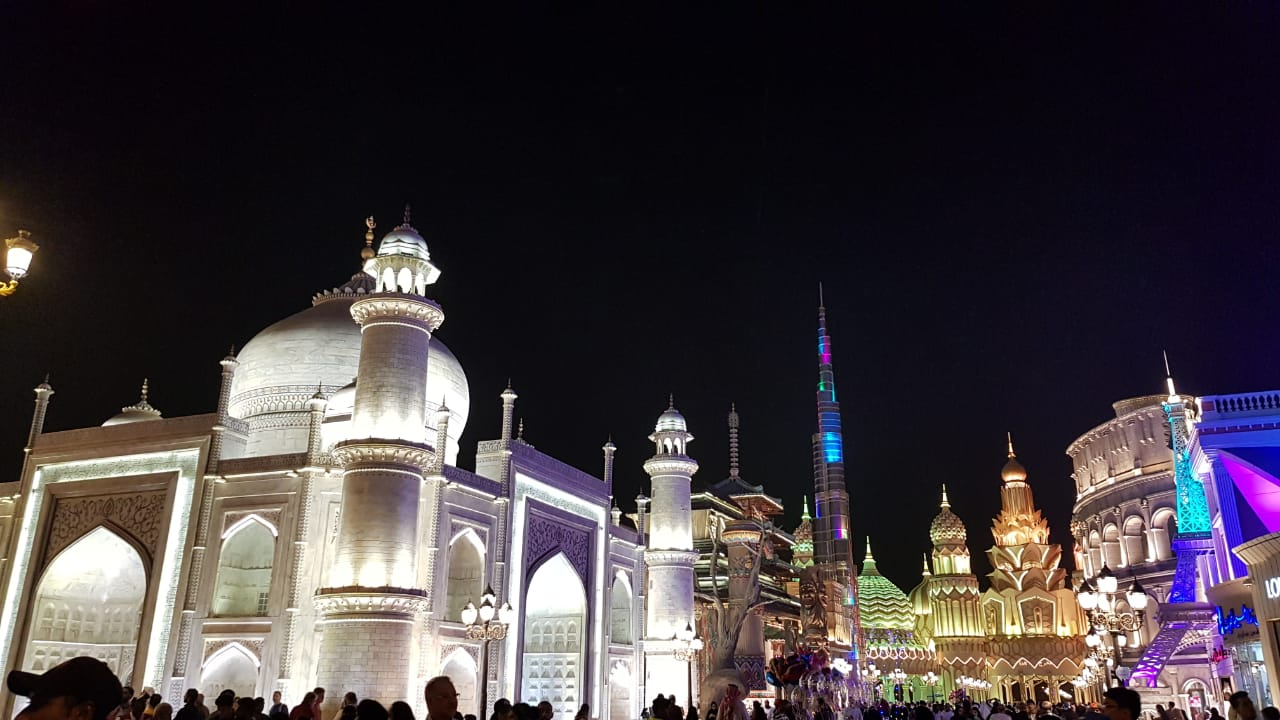
The other entrance, known as the Cultural Gate beautifully showcases key elements of Emirati traditions. The gate’s design is based on an architectural theme that is unique to the UAE. The structure showcases both wind towers that are traditionally seen on Emirati-style houses and a large structure of a Dallah or traditional coffee pot.
Each pavilion highlights elements of the culture it represents. From a gigantic hand fan and cherry blossoms at the Japanese stall, to the Iran pavilion lined with fire lamps, sculptures and a grand entrance all modelled after the ancient Iranian civilisation. Just taking in the details that go into each stall can take you a while.
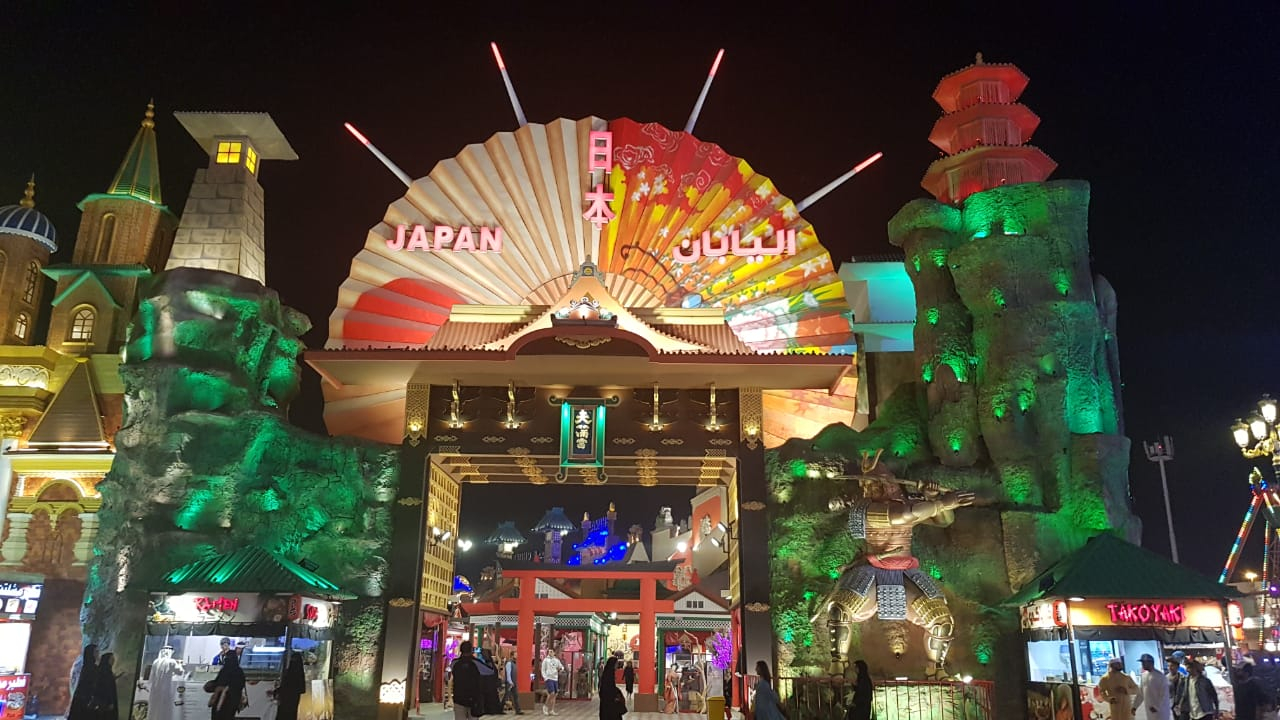
Daggers from Yemen
Jambia is a specific type of dagger with a short curved blade and a medial ridge that originated from Yemen. Men typically above the age of 14, wear it as an accessory to their clothing. The handle of a janbiya tells the status of the man who wears it.

The hilt and the sheath of the jambiya are set in elaborately crafted, very high quality silver. The silver is cast in parts with decorative, floral and geometric motifs, chased, features openwork and is engraved or composed from soldered silver wire.
Some other sights you should not miss
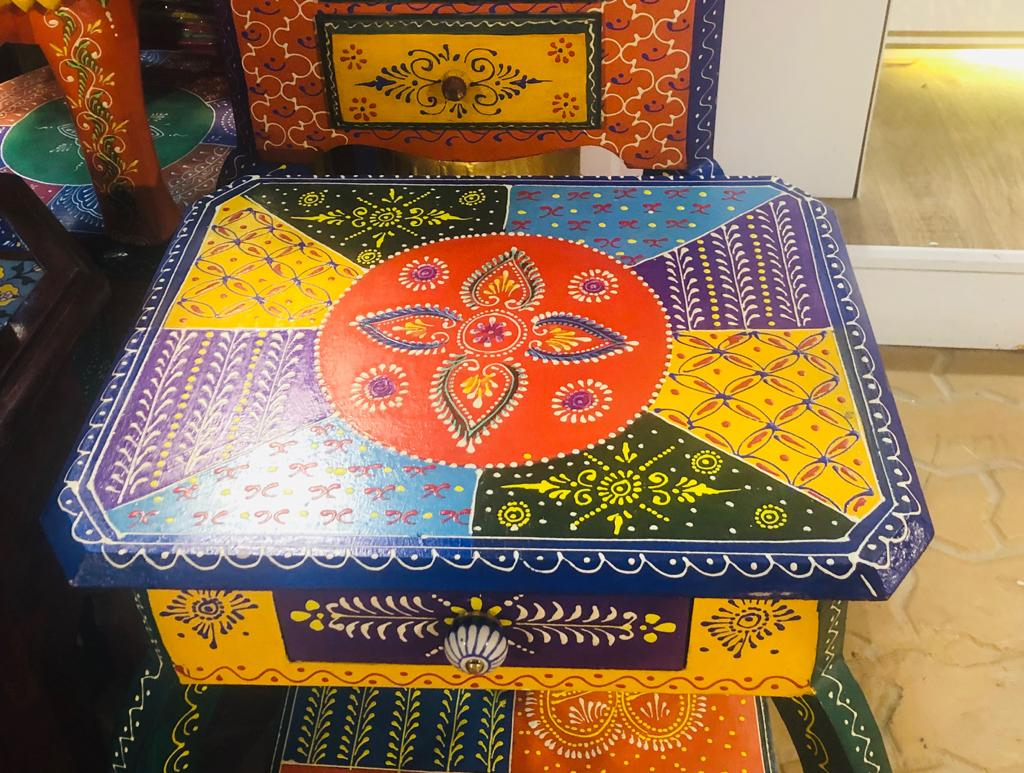
Taste
Step into GV and you are bound to feel your mouth watering - freshly made Afghan bread, saffron-infused desserts, Bosnian kababs, Lahori tawa meat, corn on the cob, roasted chestnuts or spicey potatoes on a stick.
If you are a lover of grilled meats, then this is the place to be. From burgers to steak with Raclette cheese, it is a carnivore's delight. You cannot miss the Tawa or flat iron griddle preparations from Lahori Adda, the fresh bread at Afghan Pallow Restaurant, spiced chickpeas with a dash of lime or chana jor garam from the vendors walking around and baked potatoes from the stall outside the Turkey pavilion. Prices range from Dh27 for the baked potato to Dh15 for the chickpeas. The Lahori Adda menu has varying prices but nothing more than Dh50. They also have a rather exemplary Punjabi Cholay Bhature or spiced chickpeas with fried bread.
Have a craving for freshly-made saffron jalebis - Punjabi Village has the answer. Located in a cart just outside the restaurant, the vendor pours concentric circles of the chickpea-yogurt mixture into bubbling oil. Within seconds it gets steeped in saffron-sugar syrup, and you have a pile of steaming hot jalebis waiting to be demolished.
Bosnian kababs is whole new ball game. Made primarily of minced beef, it is served with sour cream, feta cheese, minced onions, bell peppers and other spices. It is melt-in-the-mouth succulent. A must try, again.
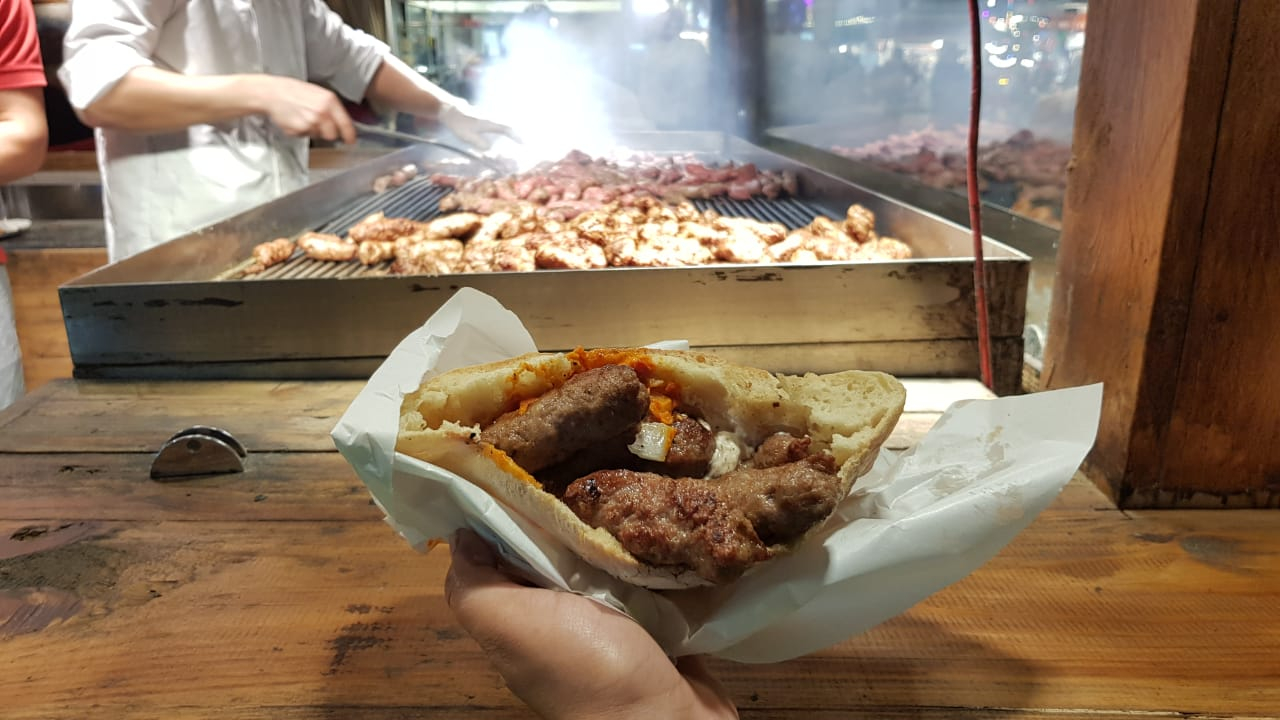
Moving on from Bosnia, you have the Turkish offerings, which include Borek or stuffed flaky pastry and Turkish Delight or Lokum. The latter is a sweet made of starch gel and sugar syrup infused with flavours and nuts.
Then you have the answer to every cheeselover's dream - a giant wheel of the cheese, and pasta made inside it! It looks like something that would easily fit into the world of Charlie and the Chocolate Factory. Quite innovative but people swear by it. The prices range from Dh30 to 35.
Smell
Attar, bukhoor and lobaan
It might be a surprising piece of news, but what draws many visitors to global village are the perfumes and fragrances that are on sale. While there is always the odd deal you can get on French, branded perfumes, what is unique to Global Village are Arabian perfumes. Here is a list of what you can get your hands on:
UAE
The UAE pavillion has some of the best perfume houses in the country selling attar or traditional perfume oils, bukhoor or wood-based home fragrances and lobaan or frankincense.
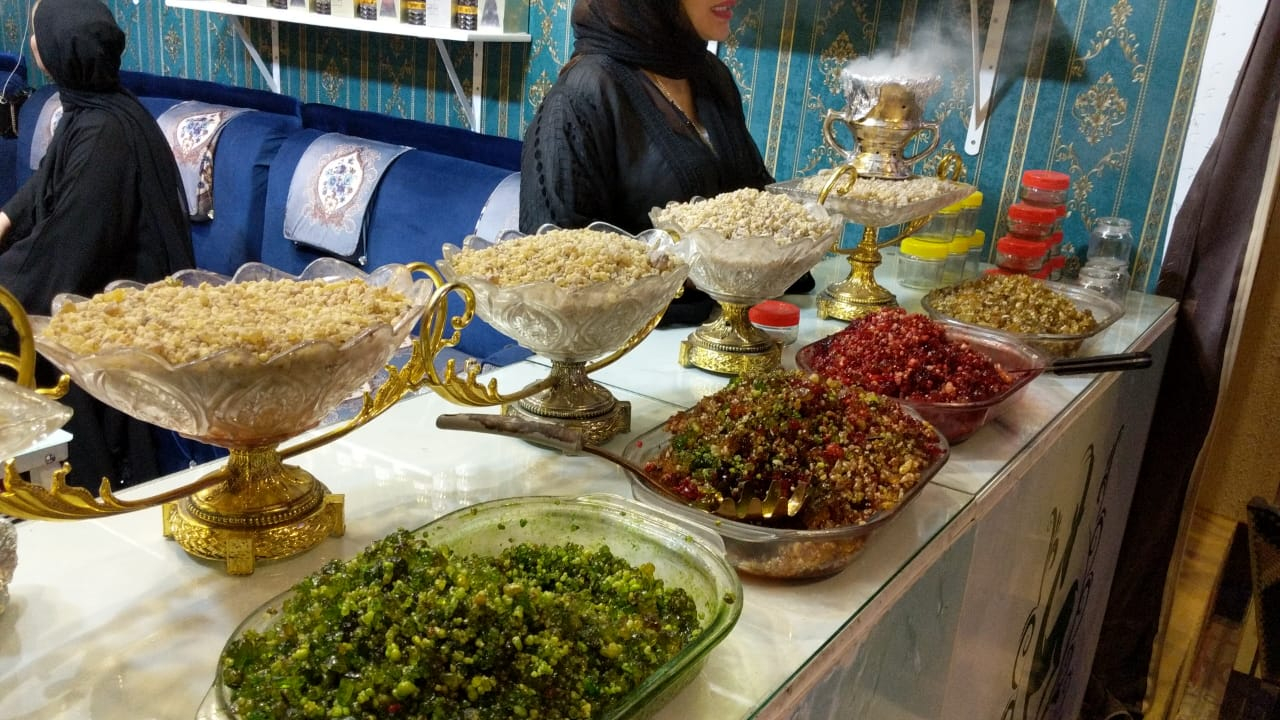
One of the retailers at Global Village, Shaikha told Gulf News that her mother had been making bukhoor and lobaan at home for over 25 years.
“We bring the lobaan from Oman, as it is original. Commercial loban melts very easily and is not the best quality. We then soak the lobaan in essential oils and fragrances - some French mix and some traditional Arabic ones - and leave it out in the sun for three to four months, regularly turning the mix, to make sure it soaks in all the oils. This is an Emirati tradition and the ones that we make at home last longer because of the traditional process that we follow,” she said.
Kuwait
One of the pavilions with the most number of perfume shops is Kuwait. Wondering why? According to Nader Al Ali, one of the retailers, Kuwait has been known for its perfumes for many years in the Gulf region.
“People who come to Global Village and the Kuwait pavilion in particular come for the perfumes from Kuwait because for many years Kuwait has been famous for its perfumes,” he told Gulf News.
His most expensive perfume? Dh560 for an 80ml bottle of an oud-based mix. However, many perfume houses said they were selling popular perfumes on a discounted rate at Global Village as it might attract new customers.
Al Ali’s company, for example, sold one of their most popular perfumes Al Ustoora, for Dh300 in their store. At Global Village, however, the price was reduced to Dh200.
Morocco
Pefumed creams, body lotions and frankincense can also be bought from the Morocco pavilion, as the country has a rich tradition of creating fragrances from natural resin. Sara Hanachaoui spoke to Gulf News about the lobaan that was being sold - lavender, rose, amber or a mix.
“All the ingredients are from Morocco, the essential oils and the dried petals that we use,” she said.
French perfumes
Those looking for a deal on branded perfumes can also find discounts on popular frangrances in shops that have opened up in many pavilions.
Spices and herbs
The history of spice is almost as old as human civilisation. In the Middle East, its history can be traced back to as long ago as 3500BC when ancient Egyptians were using various spices for flavouring food. They even used it for cosmetic purposes and to embalm the dead. For almost 5,000 years, Arab middlemen controlled the spice trade. In fact during the Middle Ages, spices were as valuable in Europe as gold and gems and it was the single most important force driving the world’s economy. But then European explorers discovered a sea route to India and other spice producing countries in the East.
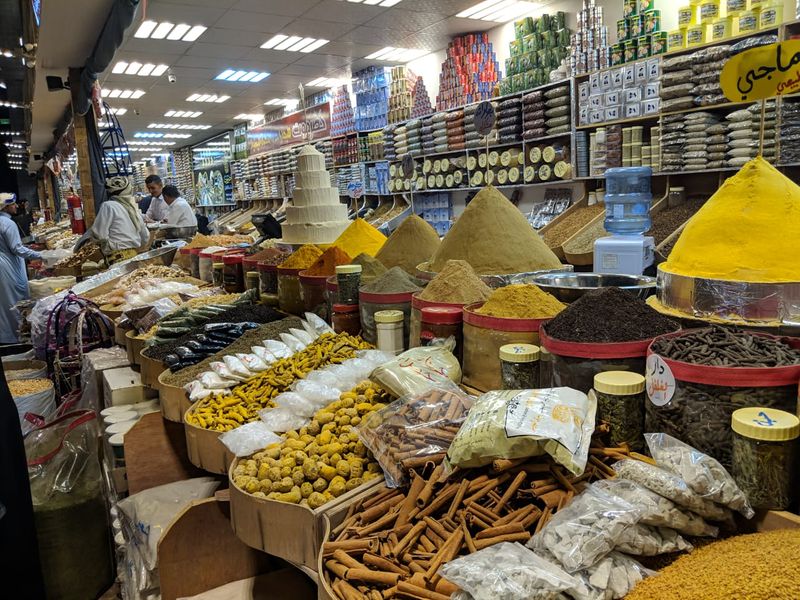
There are many health benefits of spices just for their unique properties and aroma. Take this: ‘Cumin’ is a digestive with 'cooling' properties. It has been known to relieve flatulence and colic. In the East, people consume it to increase lactation and reduce nausea during pregnancy. Coriander has multiple benefits, too. The coriander seed oil is a stimulant, often used in digestion. It is a stomach soother for adults and colicky babies. Coriander also contains substances that kill certain fungi and bacteria, preventing infections from occurring. Sprinkling some coriander seed on minor cuts and scrapes actually produces some anti-inflammatory effects. Turmeric is used as a culinary dye in desserts. It is also a stimulant, a mild digestive and an antiseptic. Cinnamon is used to reduce cholesterol, blood sugar, and triglyceride levels. This fragrant spice is also known to help treat diarrohea. Fenugreek gives off a bitter, burnt taste. Medicinally, however, fenugreek can be ground, used as a lip balm and tonic. The seeds can also be soaked and steeped into a tea to aid in reducing fevers and menstrual pain.
Syria, Morocco, Yemen, Jordan, Iran and Afghanistan pavilions are a hit for the aromatic herbs and spices displayed here. There is lavender, lemongrass and a various spices specific to the region, with some of them being touted as a cure against all ills. The aroma from these spices is overwhelming to say the least with a mix of sweet and savoury smells. Some core spices like coriander, fenugreek, cinnamon, cardamom, chili and turmeric leave a unique aroma on your fingertips for hours after you touch them in order to smell them.
We also discover some very specific spices like black cardamom (Dh60 per kilo), saffron (Dh200 per kilo), and black dry lemon (Dh50 per kilo).
Don’t miss the ready-made fish masala powder in Afghanistan pavilion for Dh80 per kilo. There is also a ready-made special Jalalabad biryani masala (also for Dh80 a kilo), a powdered mixture of spices like cardamom, rose flower, saffron, clove, chilli among others is very aromatic.
Jordan: Healthy buys
Sage water, rose water, orange blossom water, fennel and marjoram water are a must-have at home for people of the Levant. They are considered an instant remedy for multiple illnesses and you can find them at the Jordanian Pavilion in Global Village.
Distilled herbs are made by boiling the plants, and gathering the steam, which turns to condensed water using a special apparatus. Sage water is mostly used for the stomach. The cure for many digestive problems, including loss of appetite, flatulence, stomach pain, diarrhea, bloating, and heartburn is drinking a little bit of sage water. It is also used for reducing menstrual cramps and for depression. Sage in Arabic is called ‘Merameyeh’, the name is believed to have comes from Mother Mary, in Arabic Mariam. In Palestine it is believed to be a blessed herb and used for all illnesses, as the story is that Mother Mary when she was running away toward Egypt with baby Jesus, she sat under a tree to rest, cut some herbs and rubed her face with it to cool down, and she said the words “God bless you”. And until today all women of Palestine believe it’s a blessed herb and that’s why it is found in the homes of many healers.
Orange blossom water is used for calming the nervous system and helps in digestion, and is added to some Middle Eastern deserts. While rose water is mostly used for beauty purposes, fennel is very helpful for babies bloating and in lactation and for getting a deeper sleep at night. Fennel also helps in calming a cough, and in asthma attacks. Marjoram water on the other hand has all the benefits in the world, but mostly it's used to help in inflammation, especially joints and muscles, hormonal imbalances, lowers blood pressure, and lowers blood sugar.
Sounds
As you step in through the gates of Global Village, sounds from all directions welcome you. From cultural shows at various pavillions, and bikes zooming by at the superloop stadium, to concerts and flash mobs to the turkish ice-cream hawker’s bell, the place is a treat for your ears.
Just for a price of Dh15 that you pay to enter the Global Village, here is a list of things you must experience.
The Emirati sword dance
A UAE heritage village has been set up in Global village where visitors can get a glimpse into Emirati traditions. Here you are welcomed with the glint of swords being tossed up in the air. It’s the traditional sword dance or Yowla. Boys and young men spring from foot to foot, manoeuvring the sword, spinning it between their fingers rhythmically to the Emirati music accompanying the dance.
The African heritage village
From the African drums to wooden xylophones, this pavilion offers so much for those interested in music. As you walk in, you see rows of these instruments lined up against the wall. African nationals, who are in Dubai just to exhibit their products at the Global Village, approach you, asking if you would be interested in giving the drums a go.
One cheery exhibitor, Mamadou Gueye, a Senegalese national, picked up one of the large drums and played a tune that attracted the crowds towards him.
He then told Gulf News: “These are traditional drums from my country. They are made of wood and leather, made from gazelle skin. We only use our hands to play them, no sticks are used. We play on all occasions.”
Puppet shows
Right outside the Indian pavilion, every few hours, visitors gather around a small stage where puppets dressed in bright clothes wait for the puppet master to take control of the strings.
Soon, a loud Bollywood song plays and the puppets come to life.
Puppetry is a very ancient folk art form that was used throughout Indian history, for storytelling. Puppets from different parts of India have their own identity. The traditional puppets of Rajasthan are known as Kathputli, a combination of two words ‘kath’ (wood) and ‘putli’ (doll). The music that accompanies, blends folk and classical elements of music from the region. In West Bengal, it is known as Putul Natch. Here the puppets are made from clay and rice husk and mostly depict scenes from ancient Indian epics like the Ramayana and the Mahabharata. Similar variations of the art form are the Sakhi Kundhi in Orissa, Goyambatta in Karnataka, Bomalattam in Tamil Nadu. Shadow and glove puppets are also other forms of puppetry popular in India.
Cultural performances
On a daily basis, visitors can witness all kinds of cultural shows, which are hosted by the various pavilions, multiple times in a day. The shows feature over 100 professional performers who have been selected from an audition of 3,000 performers from around the world.
Additionally, there is a special international cultural show every month that is performed on the main stage. The season launched with a show from the Philippines. And they have shows from Argentina, the region and even Japan in the pipeline.
The Morocco pavilion is one to put on daily performances. Musicians take to the stage to sing traditional Moroccan songs and play loud music. Music in the country is characterised by its great diversity. There are several forms, such as Berber, Rwais, Andalous, Nuba, Milhun and several others.
Bahrain also puts on a show, highlighting traditional music of the country, sawt music, a bluesy genre influenced by African, Indian and Persian music.
Music concerts
In addition to this, visitors can watch concerts on the main stage every Friday at 9pm, completely free of charge. Leading global performers, including Ustad Rahat Fateh Ali Khan and Shreya Ghoshal, will be performing live, with a total of 23 concerts scheduled till the end of the season.
Global Village is by far the most ‘value-for-money’ destination in the region for visitors to spend quality time with their family. It is no surprise when Bader Anwahi, CEO says, in an exclusive interview to Gulf News, that during the first 50 days of its operations, more than two million guests visited the cultural fair, the highest in its history.
Jason Derulo recently performed and so did Bollywood superstar Shah Rukh Khan who enthralled visitors on the main cultural stage. From the region, singers Assi El Hallani, Essa Al Marzouq and Hamad Al Ameri proved a big hit. Rave reviews have been pouring in for Malevo Argentinian dance troupe who were one of the finalists at America’s Got Talent and got a chance to perform on centre stage. As well Filipino R&B performers Urban Crew, also from Asia’s Got Talent hit it with the crowd. “There are more interesting shows and artists lined up for rest of the season,” adds Anwahi.
“Our entertainment team travels around the world to recruit the best talents who deliver a variety of bespoke shows, kids shows, stunt shows, street entertainment, cultural shows and even circus shows, which all are meant to draw smiles on the faces of our guests of all ages and make sure they get the best times that makes them take the best memories from their visit and come back to visit us again and again.”
Besides the shows and concerts, from an entertainment perspective, there are several other attractions that are luring the audience. Dancing fountains with fire and water displays, an interactive theater hosting a variety of events and workshops for children among them. The circus show is back again this year with daring performers. For thrill seekers there is the Super Loop, a vehicle stunt show featuring breath-taking performances by 30 stunt men. For those who want to learn about Emirati culture, head to the ‘Live our Heritage’ festival to get a glimpse of local art and craftsmanship.
Stage shows
This season, visitors can witness several live performances at Global Village’s main stage. Every day, different performances are lined up to entertain viewers, while the venue uses latest light and sound techniques and special effects to awaken your senses.
One of the most popular ones was a Bollywood performance, where young men and women took to the stage and danced to popular tunes. Before the performance even began, visitors gathered around the stage, holding their phones, waiting to capture the dances on camera. Songs from popular Bollywood movies like Padmaavat, echoed around the village, with dancers doing what they do best, along with constant costume changes.
For a full list of shows, log on to https://www.globalvillage.ae/entertainments/events-calendar/
Flash mobs
If you are lucky, as you walk inside the Global Village, enjoying a snack, a team of young dancers clad in shiny clothes will surprise you. They arrive in a buggy with big speakers, dancing to contemporary popular music. With their well coordinated dance moves, they enthrall huge crowds that quickly gather around them and pull out their phones to get a video.
Fireworks
The most popular sound event, and a wonderful sight are the firework displays that take place every Thursday and Friday at 9pm, in addition to special public holidays.
Touch
Soft, furry, bumpy, beady…. These are just a few of the materials that you will touch when you make your way through the pavilions of Global Village. As self-proclaimed shopping experts from Gulf News walk through and look for bargain buys. We discovered that the prices in Global Village are competitive and the best part is that you can get literally almost anything in one space. Precious stones, wedding dress fabric, beaded clutches, leather jackets and high quality cotton.
Here are the top discoveries for shopping in Global Village
Yemen: Get your precious stones from there
Yemen is famous for its unique agate oe aqiq gemstones, for centuries its unique colours and rare sizes made it very famous worldwide. The process of production of agate is confined to part of old Sanaa alone. The gemstones are extracted from the high mountains of Yemen, and mostly the older generation believed in the stone benefits in suppressing negative energies, and to help in minimizing pain. You will find many colours, and sizes of the stone, mostly on silver rings for both men and women. Prices range from Dh150 to Dh1000. Depending on the purity and rarity of the stone.
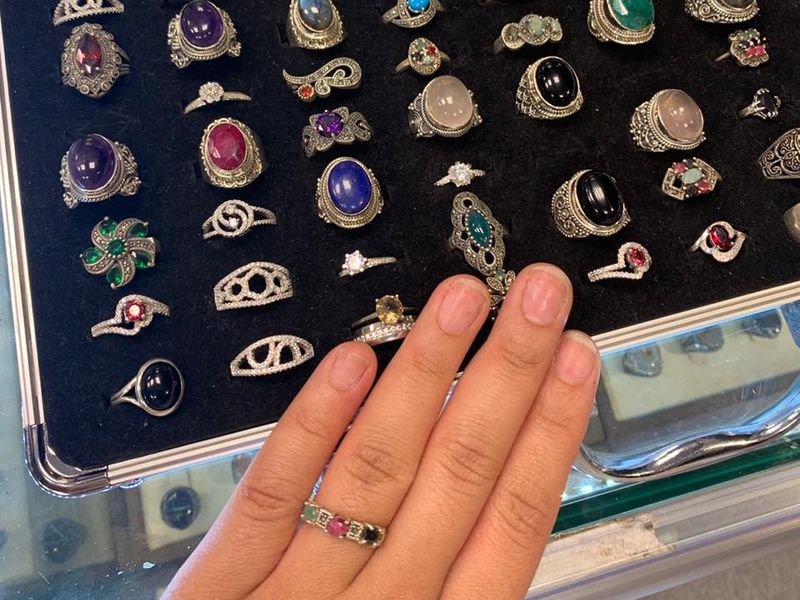
China: Great beauty buys
China was full of affordable make-up, jewellery and one of their most popular items, false eyelashes. This place has hundreds of different types of them and they were really affordable, especially because the quality of the lashes are right up there with high-end make up stores. China was also home to cheap jewellery, make-up including brushes, eyeshadows, lipsticks and nail polish.
Pakistan: For fur and leather jackets
Fur and leather shops in the Pakistan Pavilion have become a destination for residents and tourists. The country has became famous for the best quality fur and leather jackets that can be bought, with reasonable prices.
A fur jacket is a lifetime purchase, and a fashion statement for many women, so the pavilion boasts dozens of fur and leather stalls selling jackets, coats, scarfs, and hats without breaking the bank. One long fur coat that cought my eye, and looked very unique, was on sale for Dh7,000. Asking the maker from where he got the fur from, he informed us that it was sourced from Germany.
Afghanistan: It’s where you should buy your carpets
The colours and textures in Afghanistan were overwhelmingly beautiful. One particular piece that caught our eye was the Kilim rug. A flat woven carpet made out of wool, that was made in the same manner since ancient times. Kilims are not exactly rugs, they are different in their own way, woven by only women, and takes one-and-a-half months to be done with one of them. Its famous in north Afghanistan mostly. You will find many colours and sizes of that colourful rug, which you can use as a floor cover or a prayer mat and also as a decorative item on the walls of your house.
Morocco: Berber traditions
Fabulous Berber carpets in their traditional white, cream and black patterns are exotic and beautiful. You even have tribal symbols woven into it - the pieces are like history and would look equally elegant as a wall hanging.
You can also see how a carpet is being woven at the Morocco pavilion. Mahjouba, who lives in a village on the outskirts of Fez, in Morocco, demonstrates the special loom, which takes about 20 days to make a metre-and-half long carpet using sheep wool dyed in natural colours. She told Gulf News: "I've been weaving carpets for 23 years. My entire village weaves carpets - that's what we do."
Unique fabrics and shoes
The Global Village is a shopper’s paradise for sure. Fabrics, clothes, bags, shoes, momentos, souvenirs from Dh2 (yes that’s right, have a look inside Pune accessories in India pavilion where all items are priced at just Dh2) going all the way up to six-digit tag price - there is something for all there.
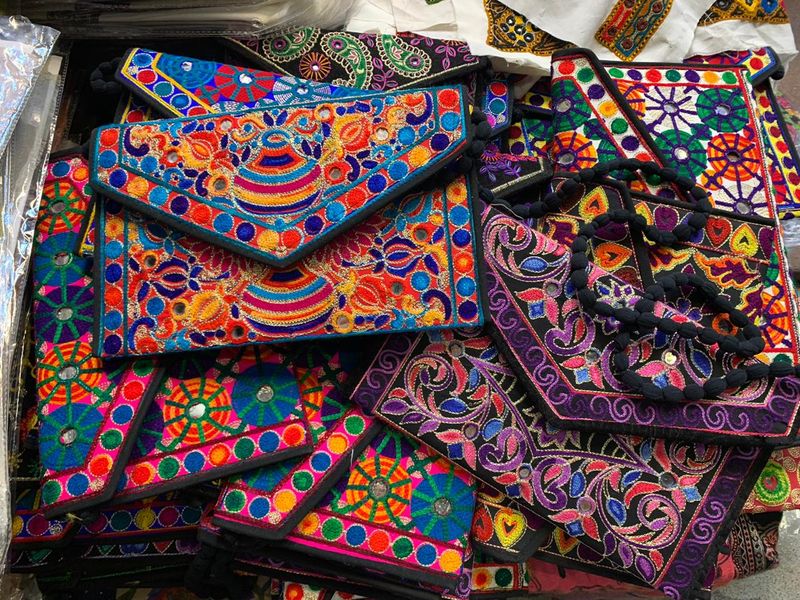
As Gulf News took a stroll around the village, we come across some interesting things for sale. Unique fabrics and shoes particularly caught our attention. We all know Pashmina shawls are popular, but have you heard about the rare shatoosh shawls that are gaining popularity among visitors?
For the uninitiated, shatoosh is an Iranian word that means ‘king of fine wools’. These shawls are special because they are woven from the chin hair of Tibetan antelope (chiru). It is seriously a work of art by craftsmen and women who put together the shawls in Kashmir. We take a look at one that is priced at a staggering Dh25,000. It is white and hence so expensive. Other similar shawls are priced between Dh15,000 and Dh20,000. Touch the piece and it feels as smooth as butter. And yes it is so light it can pass through a ring. Rest assured it does the job to keep one warm.
At one of the stalls in the Pakistan pavilion, Ahmad, a salesman takes pride in promoting a special net piece. “It is priced Dh500 a meter as the design on the fabric is completely hand-made in Pakistan. There is fine embroidery and sequins on the piece,” he said.
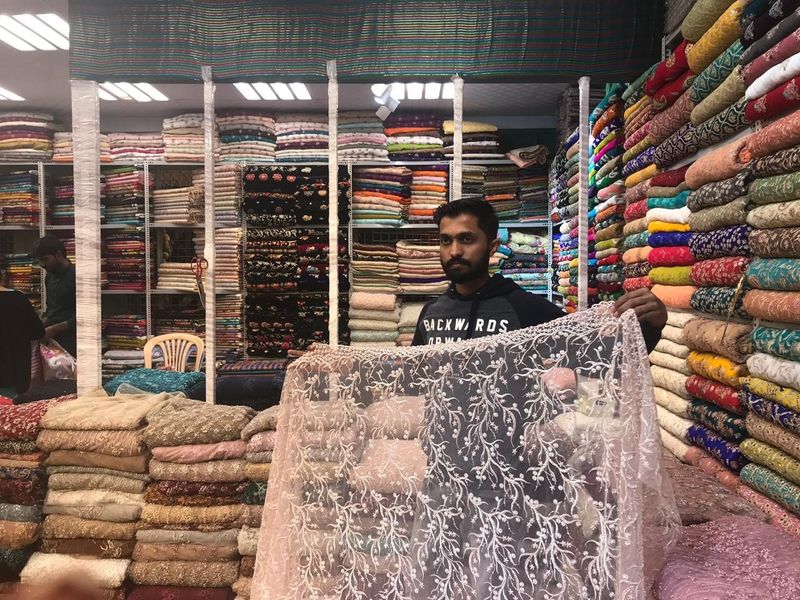
The material feels soft and the sequins on the piece is not going to hurt the skin at all. “Every year we see a huge demand for Pakistani materials in the village. We have customers from all over the world and sometimes they come with specific request of a particular material.”
At the India pavilion some colourful juttis or shoes catch our attention. Juttis are a type of footwear common in northern parts India and Pakistan. They are made of leather and usually come with extensive hand-made embroidery. What is special about the shoes is that it is completely hand-stitched. In the case of some footwear, threads of original gold and silver are used to design it. The work on the juttis are really smooth and the vibrant colours of threads used to stitch it, leaves them looking attractive and very appealing to the eye. A pair of juttis are priced at Dh150 at the village.
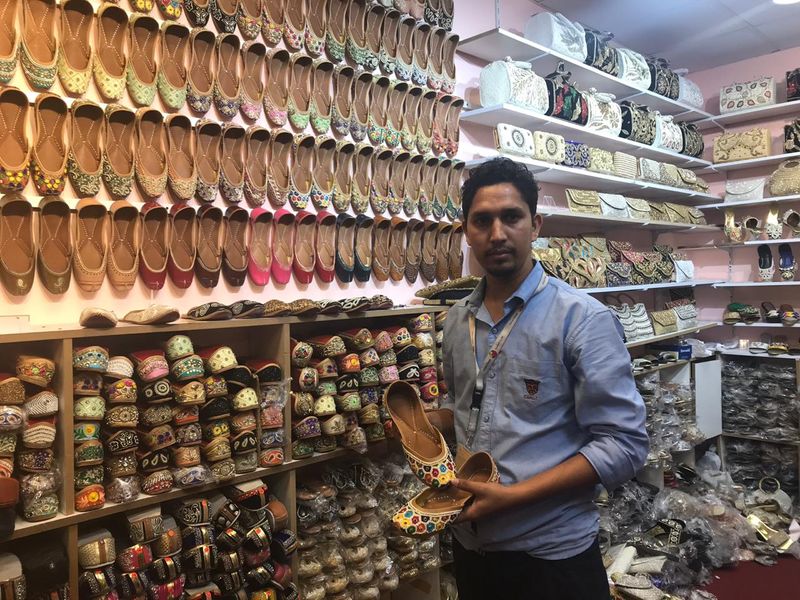
People come for many reasons - what are yours?
Tourists from London, Dr Ahmad Zuaiter and his wife, who were visiting their daughter and grandchildren in Dubai, were upset when asked if they liked Global Village. Why? Because they could not believe that they had never been to the carnival before!
Zuaiter said: “We have visited Dubai so many times and we had never come here. This place is more variable and has so many people. You see more people here, much more than you can see in Disney Epcot, and we go there all the time. It is more impressive and very good.”
From eating Kunafa in Syria to buying a saucepan in the Jordan pavilion, the Zuaiter’s enjoyed their experience and are looking forward to coming again.
Prabhu Devraj enjoys Global Village so much that he travels from Abu Dhabi to Dubai, with his family, to spend a day at the fair. He said: “We are visiting many countries in one place. My children like it too, so whenever the new season starts, we visit three to four times. There are a lot of eateries available here from different countries. I love the food a lot!”
Dubai resident Angela Aveidat is also a fan of Global Village food and enjoys “the luqaimat from the Emirati pavilion”.
Echoing the same, Sharjah resident Melra May Delombar visited the fair to have the “biryani from the UAE pavilion”. She brought her baby, Akira, to show her the lights.
For 10-year-old Sami Aveidat, who is a seasonal visitor, the amusement park extension of Global Village has his heart. He told Gulf News: “All the rides are really fun and you get to win cool prizes.” He also liked how the place is designed because “it lets you visit different countries without travelling anywhere.”
Emirati resident Abdullah Alali won a toy at the amusement park and told Gulf News he comes to the carnival especially for the rides and games. He added: “I always go to all the pavilions and games. Everyone who comes here will leave happy.”
More than the entertainment and the activities, many visitors love the atmosphere and the spirit of harmony that can be experienced while at Global Village.
Ajman resident Mirna Michael Dewan, told Gulf News: “There is a lot of diversity here. The entire world and all nationalities get to come together in peace. They have a chance to enjoy each other’s cultures. There is a mash-up of cultures and people get more knowledge about other countries.”
Carlos Picolo, a tourist from Portugal had visited Dubai twice, but it was his first time at Global Village. He said: “The feeling is amazing. There are a lot of people and a lot of things to do. I love it. I like everything about the place.”
Vijaya Sinha, an Indian tourist from the US, was catching a flight back home the same evening she visited: “We came to Global Village as a part of the places we had to see in Dubai. I just love the diversity. It is lovely to see so many different cultures in one place.”
On being asked about her favourite attraction, she said: “What was particularly a favourite was the natural foods. There are many kinds of honey for instance… which you don’t get to see in India. There were spices similar to what we find in India, as well as some new, different ones. It’s an awesome experience.”
A must visit: Emirati entrepreneurs
Al Sana'a, a Ministry of Community Development initiative has a strong presence at Global Village. Emirati entrepreneurs whose home-made products do not have a retail presence in the UAE, have found a massive platform at the Global Village to showcase their products, all thanks to Al Sanaa.
Fifty nine kiosks displaying products made by Emirati families – from perfumes, chocolates, cookies, clothes, artefacts – are a must-visit at the fair this year.
Gulf News took a look inside the pavilion and found other interesting displays like embellished abayas and kaftans, colourful cushions emblazoned with Arabic script, hand-painted coffee pots among others, all of which are hand-made by Emiratis.
According to Sultan Eisa of Al Sana'a, this creative initiative is a developmental exhibition started years ago to support families and people of determination, in order to help them become economically and socially stable. “It aims at spreading the culture of self-employment, self-reliance and turning them into entrepreneurs. And the Global Village is a great platform for these families to showcase their products. Everyday hundreds of thousands of visitors throng the festival and they cannot get a bigger and more global audience than this.”
It is said that there are about 2,150 families registered with Al Sana'a. “To be eligible for registration, one must possess a technical skill or a desire to learn one, and have a product which they can create themselves. The families must not have a retail outlet anywhere in the UAE and they must hand-make everything at home. The Emiratis are given a special license to run their business from home,” explained Eisa.
Of course Al Sana'a has its presence outside Global Village, but it is here at the fair where Emiratis get to show their products for the longest period of time. What is more as part of Al Sanaa, Emiratis are offered subsidised rates to set up their kiosks. All sales made at Al Sanaa goes to the families.
Fatima Khalfan Al Nuaimi and her sister Khulood Khalfan Al Nuaimi said they are lucky to have been given an opportunity to set up a kiosk at Global Village. The sisters who run their own business called ‘Softy Cookies and Flavours’ make delectable sweets and cookies from home. Their sweets have been selling hot cakes at Global Village. Prices are around Dh80 per kilo.
“My sister and I love to bake and cook. When we were given an opportunity to be part of Al Sanaa, we decided to narrow our focus to making fresh organic sweets. I am glad people are enjoying our products,” she told Gulf News.
Emirati mother, Umm Abdullah, makes perfumes in the comfort of her house. Her stall is garnering a huge interest from people who just want to know how she does it from home. “It is very simple. I have all the necessary ingredients and just mix them up to create the right fragrances. The perfumes are stored in glass bottles and I am trying to keep this whole concept of perfume making as plastic free as possible.”
Another Emirati entrepreneur who wished to remain anonymous owns a children’s clothing stall called Mini Me. “The Global Village is a massive platform to showcase our products. I have taken a space for six months. The rate for my stall is very subsidised, and I am paying Dh35,000 for it. Proceeds of the sale all come to me,” she said.
Enjoy - calling the child in all of us
There are more than 30 exhilarating rides for families, children and adrenaline junkies. Also, there are more than a 100 arcade games in an arcade building.
Low-cost tickets - how does GV manage?
When asked about how feasible it is for the Village to operate with such low entrance fees, in an email response to Gulf News, the Bader Anwahi, the CEO said: “We operate on a smart business model that has multiple revenue streams through our various offerings and we have the advantage of continuously updating it according to market change in means that sustain our growth over the years and at the same time continue delivering the best experiences to our guests. It is the flexibility we have in our business model and the continuous adaptations to the various practices in the industry that has allowed us to grow over the years to become an international destination.
“We are proud of being an Emirati brand that has grown over the years to now become an international player in the family entertainment industry and the world’s leading multi-cultural festival park, which differentiates us from other theme parks. Our brand gives us flexibility over other theme parks to maintain low cost of entry for our guests. We position ourselves as a family destination and we set our entry ticket’s price at a rate that makes us a destination of choice to families of residents and tourists alike.”
Other things you need to know...
- Global Village will be open until April 6, 2019. Gates open from 4:00 pm until 12:00 midnight Saturday to Wednesday and until 1 am on Thursday, Friday and public holidays. Mondays are dedicated to women and families.
- Handy guide to facilities at the village:
- Money Exchange
- ATMs
- Lost & Found Desk
- Mothers’ Rooms
- Prayer Rooms
- Three Information Booths (How Can We Make You Happy Kiosks)
- Washroom Facilities with wheel chair access
- Guests Happiness Centre
- Dubai Police’s Al Ameen Room
- Guided Tour Services
- Lockers
- 300+ Baby strollers
- 400+ Shopping Trolleys
- 70+ Porters
- 100+ Wheelchairs
- Clinic
- 12 Ticketing Vending Machines
- 5 Mobile Charging Units
- 10 EZ Taxi Club Cars
We know, that's a lot to take in. And, we promise this is just the starting point. But, the good news, Global Village will open right through to April, so you have enough time to discover and make your own favourite memories. If you liked this piece, let us know on our Facebook page or email us on readers@gulfnews.com.
To view this year's map, click here.


